
As the world of work continues to evolve, the significance of understanding employee functions in 2024 cannot be overstated. In a constantly shifting landscape, having a comprehensive grasp of the roles and responsibilities within your organization is crucial for success. So, how can we dissect the concept of employee function and ensure that we’re positioned to tackle the challenges of the modern workplace? Let’s dive in and uncover the secrets behind effective employee function management.
Key Takeaways
- Employee function is the set of roles and responsibilities assigned to an individual according to their job description.
- Job descriptions are essential for setting expectations, providing metrics for evaluation, clarifying roles & responsibilities, and ensuring adherence with labor laws.
- Organizations must adhere to tax & labor regulations by properly classifying employees in order to protect themselves from legal actions.
Employee Definition
An employee definition refers to the explicit delineation of an individual’s professional status within an organization. The employee definition encompasses various facets, including contractual obligations, job responsibilities, and the overall relationship between the employer and the individual. Clarity in the employee definition is crucial for both parties to establish mutual expectations and foster a productive working environment. It outlines the scope of work, expected contributions, and the terms under which the individual is engaged with the organization. A well-defined employee definition not only aids in legal compliance but also serves as a foundational element in promoting transparency and effective communication within the workplace.
Defining Employee Function
Employee function refers to the specific roles and responsibilities an individual is expected to perform within an organization, as outlined in their job description and employment contract. For both employers and employees, the understanding of employee functions is instrumental in determining job suitability and setting clear performance expectations.
A well-defined employee function not only outlines the duties and responsibilities but also helps establish the employee’s place within the organizational structure. This structure delineates the relationship and interconnections between different components of the business, such as employees and their functions, and determines how employees are classified and arranged according to their roles and duties within the organization.

Role of Job Descriptions
In the domain of employee functions, job descriptions hold significant importance. They:
- Clearly define the duties and responsibilities associated with a given job
- Establish expectations for performance
- Provide a metric for evaluating an employee’s performance
- Assist employers and employees in understanding the expectations of the job
- Clarify roles and responsibilities
- Ensure adherence to labor laws.
One essential element of job descriptions is the specification of benefits, such as health insurance and paid holidays, which can impact an employee’s overall compensation package. Job descriptions, through their accurate outlining of a role’s scope, aid organizations in attracting and retaining ideal candidates for each position. This ultimately contributes to the prosperity of both employees and the business.
Connection to Organizational Structure
There is a complex connection between employee functions and an organization’s structure. The structure impacts the duties of employees by delineating roles, obligations, and reporting relationships, helping employees understand their specific tasks and who they can turn to for support. Moreover, the structure can influence job satisfaction and motivation levels, which are critical factors for business owners to consider.
In the hierarchical structure of an organization, an employee’s function determines their position and level of authority. It also defines their responsibilities, reporting relationships, and decision-making authority within the hierarchy, which is often overseen by senior management. As such, employee functions play an essential role in shaping an organization’s structure and achieving business goals.
Key Elements of Employee Performance

Employee performance is directly linked to the successful execution of their functions. One way to ensure optimal performance is through effective performance standards and measurement, which help evaluate an employee’s success in fulfilling their role. Furthermore, fostering employee development and growth is pivotal in enhancing their functions and overall performance, leading to higher job satisfaction and productivity.
Attending to these key elements of employee performance is integral to an organization’s success. Companies can prepare their workforce to confront modern workplace challenges and contribute to achieving strategic goals by setting clear performance standards, measuring success, and fostering growth.
Performance Standards and Measurement
The establishment of clear and quantifiable performance standards is fundamentally important for assessing employee function and ensuring success. Organizations can monitor employee performance, provide feedback, and make informed decisions about promotions, rewards, and development opportunities by setting well-defined goals or objectives, offering regular feedback and performance appraisals, and tracking progress.
Performance measurement tools, such as annual reviews, productivity records, and 360-degree feedback, provide tangible data to assess the effectiveness, efficiency, and improvement of employees. These tools are instrumental in setting performance standards, recognizing areas of strength and areas for improvement, and correlating employee goals with organizational objectives, ultimately leading to a more productive and engaged workforce.
Employee Development and Growth
Professional growth has a considerable influence on employee performance. When employees have opportunities for professional development and career progression, they experience:
- Increased job satisfaction
- Confidence
- Morale This leads to higher productivity and overall performance. Moreover, employee development programs can focus on specific skills and capabilities required for improved performance, further intensifying the impact of professional growth on employee performance.
To foster employee development and growth, organizations can implement strategies such as:
- Identifying employee development goals
- Providing training opportunities
- Implementing task/job rotations
- Offering coaching and mentoring programs
By investing in employee development programs that align with their respective job functions, organizations can ensure that their employees possess the requisite skills and abilities to execute their job functions proficiently and contribute to the success of the business.
What Is a Model Employee
When considering the question “What is a model employee,” it’s crucial to highlight individuals who consistently exceed expectations in their work, embody the company’s values, and contribute positively to the workplace culture. A model employee goes beyond fulfilling job responsibilities; they demonstrate initiative, adaptability, and a strong commitment to both personal and professional growth. These individuals not only meet but often surpass performance standards, setting a high bar for their colleagues. In essence, a model employee is someone who not only meets the defined criteria for their role but also actively contributes to the overall success and positive environment of the organization.
Essential vs. Non-Essential Functions

Within the scope of employee functions, distinguishing between essential and non-essential functions is of significant importance. Essential functions are those duties and responsibilities that are integral to the job and must be undertaken for the job to be accomplished, while non-essential functions are those duties that are not essential to the role but may still be beneficial for completing the job.
Recognizing essential job functions is of great importance, as it offers a thorough comprehension of each job, informs applicants of the job’s requirements, serves as a standard for employee assessment, and safeguards the company from potential legal actions. Businesses can enhance employee performance, promote a more inclusive workplace, and drive success by accurately distinguishing between essential and non-essential functions.
Identifying Essential Functions
Essential functions are the fundamental job duties that an employee must be able to execute, with or without reasonable accommodation. Identifying the tasks that form the core purpose of a job is required to identify essential functions, and that entails reviewing the job description. For new jobs, the core purpose of the job should be taken into account while writing the job description.
Understanding and identifying essential job functions is vital to ensure adherence to labor laws and establish a secure and just working environment. By accurately outlining the essential functions of each role, organizations can:
- Attract and retain the best candidates
- Ensure that employees are suitably trained and equipped to execute their roles and responsibilities
- Protect the company from potential legal actions.
Balancing Essential and Non-Essential Functions
To optimize employee performance and satisfaction, a balance between essential and non-essential functions is imperative. By delineating and prioritizing essential functions, employees can concentrate their time and energy on activities that directly contribute to their job responsibilities and objectives. Conversely, non-essential functions, while still important, may be less critical to overall job performance. Balancing these non-essential functions enables employees to allocate their resources judiciously and avoid overextending themselves.
This equilibrium can diminish stress, augment job satisfaction, and ultimately enhance employee performance. To achieve this balance, organizations can:
- Identify the essential job functions for each role
- Assess if a job function can be readily performed by alternate personnel
- Contemplate whether a function is a fundamental duty or responsibility of the job
- Evaluate the significance and effect of each function on the overall objectives and aims of the organization.
The Role of Human Resource Management in Employee Function

In aligning employee functions with organizational goals and tackling challenges, human resource management plays a pivotal role. HRM ensures that employees are suitably trained and equipped to execute their roles and responsibilities, and that they are inspired and engaged in their work. HRM also has a pivotal role in creating and executing strategies to tackle any function-related challenges that may arise, such as skill gaps or performance issues.
Human resource management, a vital component of human resources, contributes to the organization’s overall success by:
- Aligning HR strategies with employee functions
- Addressing function-related challenges
- Recruiting and hiring
- Training and development
HRM plays a vital role in ensuring that employees are in line with the organization’s objectives and have a clear understanding of their employee’s role and responsibilities.
Aligning HR Strategies with Employee Functions

A unified approach to workforce management requires the alignment of HR strategies with employee functions. It assists in:
- Verifying that the right people are in the appropriate roles, augmenting proficiency and productivity
- Workforce planning, talent acquisition, and succession planning by recognizing skill gaps and making informed choices to tackle them
- Comprehending employee functions permits the formation of specific training and development programs to augment skills and increase overall performance.
To achieve alignment with employee functions, HR can employ a range of strategies, such as:
- Organizational restructuring
- Employee retention
- Social responsibility
- Crisis management
- Aligning workforce strategies with strategic objectives
- Securing the right talent
- Understanding and aligning with business strategy
- Assessing current conditions
- Planning and implementing HR strategy
- Measuring and evaluating results
By synchronizing HR programs and policies with the precise needs and objectives of employees, organizations can optimize their workforce and drive success.
Addressing Function-Related Challenges
For any organization to succeed, addressing function-related challenges like skill gaps and performance issues is essential. To tackle these challenges, human resource management can implement strategies such as:
- Identifying employee development goals
- Providing training opportunities
- Implementing task/job rotations
- Offering coaching and mentoring programs
- Fostering a supportive work environment.
By addressing function-related challenges, HRM can optimize employee performance and contribute to the overall success of the organization. From identifying skill gaps to offering support and resources, HRM plays a vital role in ensuring that employees are equipped to tackle the challenges of the modern workplace and contribute to the achievement of strategic goals.
Adapting Employee Functions to Remote Work

Organizations and employees alike have encountered new challenges with the shift to remote work. Adapting employee functions to remote work environments requires a reevaluation of communication, collaboration, and performance management strategies. As businesses navigate this new landscape, human resource management plays a critical role in ensuring that remote employees are supported and equipped to fulfill their functions effectively.
Organizations can sustain productivity, collaboration, and employee satisfaction amidst changing work environments by adapting employee functions to remote work. HRM has a pivotal role in creating and executing strategies to support remote employees. Some key strategies include:
- Establishing clear expectations
- Furnishing training and assistance
- Promoting collaboration
- Utilizing technology
By implementing these strategies, organizations can effectively support their remote employees and ensure continued success in a remote work environment.
Maintaining Productivity and Collaboration
For any organization to succeed, maintaining productivity and collaboration among remote employees is vital. Strategies for maintaining productivity and collaboration encompass:
- Investing in the appropriate tools
- Nurturing strong personal connections
- Establishing clear productivity standards
- Furnishing necessary resources
- Constructing a designated workspace
- Executing time management techniques
- Stimulating breaks
- Nurturing social interactions
- Constructing trust
- Forming work-life boundaries.
To enhance collaboration in a remote working environment, organizations can implement the following strategies:
- Establish communication norms
- Facilitate video chats
- Define clear objectives
- Utilize collaboration tools
- Allocate time for relationship building
- Apply technology
- Foster mutual trust
By employing these strategies, businesses can ensure that their remote workforce remains engaged, productive, and successful in fulfilling their functions.
Supporting Remote Employees in Fulfilling Their Functions
Supporting remote employees in adapting to new work environments and successfully performing their functions is essential for business success. Organizations must establish clear expectations and deadlines for remote workers through a written contract, ensuring that all parties are aware of the situation and that tasks are completed in a timely manner. In addition, being cognizant of virtual body language when communicating remotely can assist in ensuring that messages are being articulated clearly and accurately.
Collaborative software can play a significant role in supporting remote employees by replicating the in-person office experience. This software can be utilized to promote communication, collaboration, and task management, ensuring that all parties are cognizant of the same information and that tasks are completed punctually. By providing the necessary support and resources, organizations can help remote employees adapt to new work environments and successfully perform their functions.
Legal and Compliance Considerations

Organizations must consider legal and compliance factors related to employee functions to ensure adherence to tax and labor regulations. Proper employee classification and compliance with labor laws, such as accommodations and essential job functions, are necessary to protect both employees and businesses from potential legal actions.
Organizations can protect themselves from potential legal issues and create a secure and fair working environment for their employees by understanding these considerations and ensuring compliance. Human resource management plays a vital role in addressing these considerations and ensuring adherence to tax and labor regulations.
Proper Employee Classification
As a business owner, it is crucial to ensure correct employee classification to comply with tax and labor regulations. Employees must be correctly classified for tax purposes, specifically when submitting payroll information. Employee paychecks need to have certain amounts deducted from them. This includes federal and provincial/territorial taxes, contributions to Employment Insurance (EI) premiums, and the Canadian Pension Plan (CPP).
Different employee classifications, as stipulated by labor laws, include employees work in various capacities, such as:
- Full-time employees
- Part-time employees
- Temporary employees
- Interns
- Seasonal workers
- Leased workers
- Other employees
By accurately classifying employees, organizations can ensure compliance with tax and labor regulations, protect themselves from potential legal actions, and create a secure and just working environment for their employees.
Ensuring Compliance with Labor Laws
For organizations, compliance with labor laws and regulations associated with employee functions, such as accommodations and essential job functions, is of utmost importance. The key labor laws relevant to employee functions include:
- Fair Labor Standards Act (FLSA)
- Family and Medical Leave Act (FMLA)
- Uniformed Services Employment and Reemployment Rights Act (USERRA)
- Employee Polygraph Protection Act (EPPA)
- National Labor Relations Act (NLRA), which often involves union contract negotiations
- Americans with Disabilities Act (ADA)
- Equal Employment Opportunity (EEO) laws.
By ensuring compliance with these labor laws and addressing employee requests and concerns, organizations can create a secure and just working environment for their employees. Human resource management plays a vital role in addressing these legal and compliance considerations, providing support and guidance to employers and employees alike.
Business to Employees
In the dynamic landscape of modern workplaces, effective communication is crucial for fostering a healthy relationship from the business to employees. Clear and transparent communication channels are essential to convey organizational goals, expectations, and updates. To optimize the business-to-employees interface, it is imperative for companies to establish a framework that ensures information flow is seamless and easily accessible. By prioritizing effective communication strategies, businesses can create an environment where employees feel informed, engaged, and aligned with the overall mission. This not only enhances productivity but also contributes to a positive workplace culture that values open dialogue and mutual understanding.
Summary
In conclusion, understanding and managing employee functions is crucial for the success of any organization in 2024. By defining employee functions, setting performance standards, promoting employee development and growth, and adhering to legal and compliance considerations, businesses can optimize their workforce and drive success. As the world of work continues to evolve, organizations must adapt and remain agile to tackle the challenges of the modern workplace and ensure the ongoing success of their employees.
Frequently Asked Questions
What is an example of a job function?
An example of a job function is supervising and managing a department team, providing support and training to team members, and developing and implementing protocols for increased team efficiency.
What is the function of employee success?
Employee success training and mentorship are essential for improving employee performance and retention, thus playing a crucial role in the overall success of an organization.
What are basic job functions?
Essential job functions are the fundamental duties of a position that must be able to be completed in order to fulfill the role. These duties are used to evaluate an employee’s ability to perform the job under the Americans with Disabilities Act (ADA) and include tasks such as daily activities, occasional projects, and the essential skills required to succeed in the role.
What are examples of essential functions?
Examples of essential functions include carrying a person from a burning airplane, answering the telephone and assisting callers, recording messages for department personnel, greeting clients and customers, and answering the telephone in a busy office with few employees.
What is the role of job descriptions in defining employee functions?
Job descriptions define the functions of an employee by outlining duties, setting expectations for performance and providing a basis for evaluation.